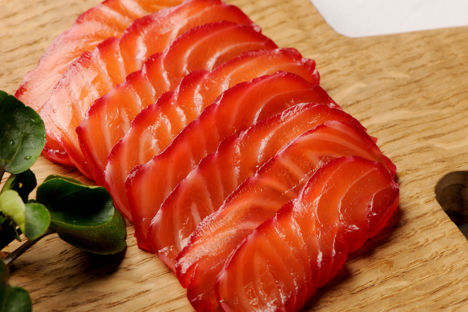Curing is used as a way of preserving meat or fish to prevent spoilage. This technique of curing salmon uses a dry cure which draws out the liquid from the fish as well as add flavour like Galton Blackiston's gravadlax of salmon with lime sorbet. An alternative method can use an acidic marinade that 'cooks' the fish like Gary Jones's ceviche of scallop and tuna, Seville orange and fennel.
Variations
There are a huge variety of flavours and ingredients than can be used to cure salmon. Citrus flavours work very well meaning you could add lemon, orange or lime zest to the cure mixture. Spices such as fennel, coriander or anise can be crushed and added to the rub, while dill is a favourite herb pairing with salmon.
Wet cures can also be used by mixing the salt, sugar and any herbs or spices with a liquid for added flavour. Spirits such as gin or vodka are popular and these often work well with citrus flavours giving a refreshing taste. Whisky has a slightly stronger flavour and adds a more robust finish to the fish, while beetroot juice adds a wonderful earthy sweetness and vibrant pink colour to the finished salmon.
The curing time is wholly dependent on the desired strength of the cure and the size of the fish used. If planning to cook the salmon after curing, it may only need an hour or so to impart flavour, whereas for gravadlax or ceviche, a longer cure is often used to give a stronger flavour and to partly cook the fish.
Uses
The cured salmon could be sliced thinly as a gravadlax or chopped to form a ceviche. Served on their own these make elegant starters or could form part of a canapé or larger dish.
If curing individual fillets, these could be cooked in the same way as conventional salmon, either by poaching, grilling, frying or baking. The cure will impart wonderful flavour to the finished dish.
Get in touch
Please sign in or register to send a comment to Great British Chefs.



